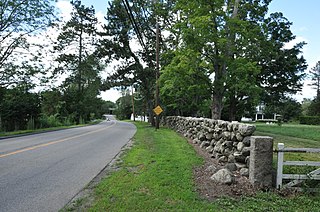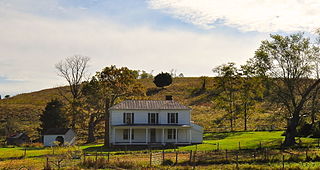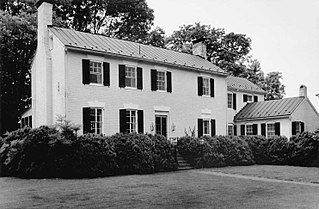
The National Road was the first major improved highway in the United States built by the federal government. Built between 1811 and 1837, the 620-mile (1,000 km) road connected the Potomac and Ohio Rivers and was a main transport path to the West for thousands of settlers. When improved in the 1830s, it became the second U.S. road surfaced with the macadam process pioneered by Scotsman John Loudon McAdam.

Horne Creek Farm is a historical farm near Pinnacle, Surry County, North Carolina. The farm is a North Carolina State Historic Site that belongs to the North Carolina Department of Natural and Cultural Resources, and it is operated to depict farm life in the northwest Piedmont area c. 1900. The historic site includes the late 19th century Hauser Farmhouse, which has been furnished to reflect the 1900-1910 era, along with other supporting structures. The farm raised animal breeds that were common in the early 20th century. The site also includes the Southern Heritage Apple Orchard, which preserves about 800 trees of about 400 heritage apple varieties. A visitor center includes exhibits, a gift shop and offices.
Burlington is a census-designated place (CDP) in Mineral County, West Virginia, United States, along U.S. Route 50 crossing Pattersons Creek. As of the 2020 census, its population was 131. It is part of the Cumberland, MD-WV Metropolitan Statistical Area.

Dudley Farm Historic State Park (Florida), also known as Dudley Farm, is a U.S. historic district and museum park located in Newberry, Florida. It was added to the U.S. National Register of Historic Places on October 4, 2002, and was designated a National Historic Landmark in January, 2021. The address is 18730 West Newberry Road. The farm is a particularly fine and well-preserved example of a mid-19th to mid-20th century farm.

The New Hampshire Farm Museum is a farm museum on White Mountain Highway in Milton, New Hampshire, United States. Three centuries of New Hampshire rural life are presented in the historic farmhouse. The museum includes a 104-foot-long (32 m) three-story great barn with collection of agricultural machinery, farm tools, sleighs and wagons. There are also live farm animals, a nature trail and a museum shop. The museum is located on the former Plumer-Jones Farm, a traditional series of connected buildings with farmhouse dating to the late 18th century and barns dating to the mid 19th century, which was listed on the National Register of Historic Places in 1979.

The William Edwards Farmhouse is a historic residence near Cincinnati in the village of Newtown, Ohio, United States. One of the area's leading early farmhouses, it has been designated a historic site.

The Wellington Farm Historic District encompasses a historic farm property at 487—500 Wellesley Street in Weston, Massachusetts. Included in the 35-acre (14 ha) district are a main house built c. 1760, a barn complex with buildings dating from the 19th and 20th centuries, a modern greenhouse, and farm fields lined by stone walls. It is historically significant for its well-preserved buildings, and for its later transformation into a summer estate. It is also one of the town's few remaining working farms. The district was listed on the National Register of Historic Places in 1988.

The Cherry Hill Farmhouse is a house museum in Falls Church, Virginia, United States. Built in 1845 in a Greek Revival architecture style, it belonged to wealthy farmer families until 1945, and in 1956 it became property of the City of Falls Church, which transformed it into a museum, as a historical building. Today, the Cherry Hill Farmhouse, along with other five such constructions in Falls Church City, is part of the National Register of Historic Places, as an important testimony of 19th century Victorian buildings in the area.
The Camp Bartow Historic District — centered on the historic inn called "Traveller's Repose" and the site of the Battle of Greenbrier River (1861) — is a national historic district located at Bartow, Pocahontas County, West Virginia, United States. It is situated at the foot of Burner Mountain, at a bend in the East Fork Greenbrier River, where U.S. Route 28 intersects U.S. Route 250.

Sugar Loaf Farm is an early 19th-century cluster of agricultural, industrial, and residential buildings located in a bucolic setting approximately 7.5 miles southwest of Staunton, Virginia and 1/2 mile southeast of Sugar Loaf Mountain. As a member of the U.S. National Register of Historic Places, Sugar Loaf Farm maintains the only surviving brick grist mill in Augusta County, Virginia. The brick grist mill on the property combines the mechanical principles of Oliver Evans, a prominent mill designer of the late eighteenth century, with the engineering craftsmanship and building detail of molded brick cornices, a vernacular architecture in the upper Shenandoah Valley in the early 1800s. The Farm's three original buildings, the farmhouse, grist mill and miller's house, were all constructed by David Summer at a time when Augusta County had emerged as the center of one of the most dominant wheat-growing and flour-processing regions in the South. Sugar Loaf Farm serves as a valuable reminder of the wheat-based agriculture that persisted in this region well into the twentieth century. Today, Sugar Loaf Farm is a privately run farm that specializes in raising Black Angus cattle.
Harris–Poindexter House and Store is a historic home, store, and farm complex located at Mineral, Louisa County, Virginia. The house was built about 1837, and is a two-story, three-bay, frame farmhouse in the Greek Revival style. The store was built about 1865, and is one-story frame building. Also on the property are a contributing smokehouse, tenant house, and a variety of early- to mid-20th century farm related outbuildings, and a late-19th century grist mill.

Bowyer–Trollinger Farm is a historic home and farm located at Childress, Montgomery County, Virginia. The farmhouse was built in four sections beginning in about 1825 and ending in about 1910. It started as a three-bay, two-story, apparently rectangular, single-pen log dwelling. Also on the property are the contributing farm office, mid-19th-century washhouse, spring house, barn, and corn crib, and an early 20th-century apple house/carbide gas lighting outbuilding.

Hare Forest Farm is a historic home and farm complex located near Orange, Orange County, Virginia, United States. The main house was built in three sections starting about 1815. It consists of a two-story, four-bay, brick center block in the Federal style, a two-story brick dining room wing which dates from the early 20th century, and a mid-20th-century brick kitchen wing. Also on the property are the contributing stone garage, a 19th-century frame smokehouse with attached barn, an early-20th-century frame barn, a vacant early-20th-century tenant house, a stone tower, an early-20th-century frame tenant house, an abandoned storage house, as well as the stone foundations of three dwellings of undetermined date. The land was once owned by William Strother, maternal grandfather of Zachary Taylor, and it has often been claimed that the future president was born on the property.

Long Meadow is a historic home located at Middletown, Warren County, Virginia. The home is located on the North Fork of the Shenandoah River and is in the shadow of Massanutten Mountain, in clear view of Signal Knob. The original homestead was one of the first settlements in the Valley and has been owned by three different families since the original house was built in the 1730s.

Sunray Agricultural Historic District is a national historic district located at Chesapeake, Virginia. The district encompasses 188 contributing buildings, 90 contributing sites, 2 contributing structures, and 1 contributing object in the early 20th-century immigrant farming community of Sunray. It includes early 20th century vernacular farmhouses, agricultural buildings, Sunray School (1922), and St. Mary's Catholic Church (1915-1916). The district also includes a tidal ditch system, the abandoned Virginian Railway Tracks (1909), and agricultural fields laid out with the platting of 1908.

The Lawrence Farm is a historic farm at 9 Lawrence Road in Troy, New Hampshire. Established in the early 19th century, the property has been in continuous ownership by the same family since then. Its farmstead, including a c. 1806 farmhouse, exemplifies the changing trends in domestic agricultural practices of the 19th and 20th centuries. The farm was listed on the National Register of Historic Places in 2000.

The Scott Farm Historic District encompasses a historic farm property at 707 Kipling Road in Dummerston, Vermont. Developed between about 1850 and 1915, Scott Farm is a well-preserved farm and orchard complex of that period. It was listed on the National Register of Historic Places in 2001.

The Hosford–Sherman Farm is a historic farm property on Vermont Route 30 in northern Poultney, Vermont. Established in the late 18th century, the farm includes the original farmhouse, now an ell to a 19th-century brick house, and a late 19th-century barn, along with more than 120 acres (49 ha) of farmland. The property was listed on the National Register of Historic Places in 1995.

Lee Farm is a historic farm property on Vermont Route 18 in Waterford, Vermont. Established in 1801, it was for many years worked by members of the Lee family, and part of a thriving rural community called Waterford Hollow. Its farmstead features surviving 19th and early 20th-century outbuildings and a high-quality Greek Revival farmhouse. A 5-acre (2.0 ha) portion of the farm, encompassing the farmstead, was listed on the National Register of Historic Places in 1983.

The Scott-Hutton Farm is a historic farm property at 1892 Turnpike Road in rural Rockbridge County, Virginia, west of Lexington. The farm property includes an early 19th-century farmhouse, to which an older log structure is appended, an early 19th-century springhouse, and several late 19th and 20th-century outbuildings. The house features fine Greek Revival styling, part of an 1843 enlargement. The early settlers were William and Ann Scott, who came to the area in 1802, and the Greek Revival alterations were made by James Hutton after he purchased the property.





















